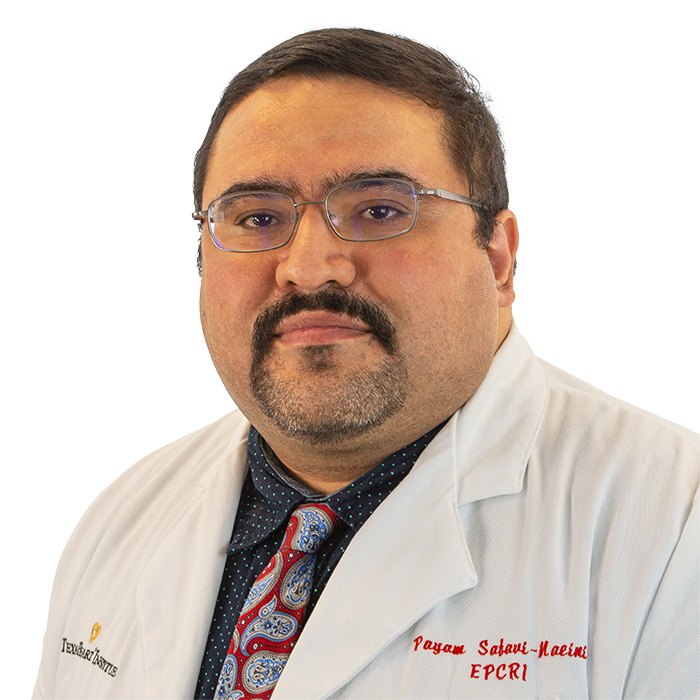
Payam Safavi-Naeini
Texas Heart Institute Positions
- Senior Research Scientist, Electrophysiology Clinical Research & Innovations
Honors, Awards and Memberships
Publications
4862227
HXDL45T9
1
alternatives-to-animal-experimentation
10
date
desc
Safavi-Naeini
2080
https://www.texasheart.org/wp-content/plugins/zotpress/
%7B%22status%22%3A%22success%22%2C%22updateneeded%22%3Afalse%2C%22instance%22%3Afalse%2C%22meta%22%3A%7B%22request_last%22%3A0%2C%22request_next%22%3A0%2C%22used_cache%22%3Atrue%7D%2C%22data%22%3A%5B%7B%22key%22%3A%228RU4J6T4%22%2C%22library%22%3A%7B%22id%22%3A4862227%7D%2C%22meta%22%3A%7B%22creatorSummary%22%3A%22Kim%20et%20al.%22%2C%22parsedDate%22%3A%222023-07%22%2C%22numChildren%22%3A2%7D%2C%22bib%22%3A%22%26lt%3Bdiv%20class%3D%26quot%3Bcsl-bib-body%26quot%3B%20style%3D%26quot%3Bline-height%3A%201.35%3B%20padding-left%3A%201em%3B%20text-indent%3A-1em%3B%26quot%3B%26gt%3B%5Cn%20%20%26lt%3Bdiv%20class%3D%26quot%3Bcsl-entry%26quot%3B%26gt%3BKim%2C%20S.%20E.%2C%20Khawaja%2C%20M.%2C%20Kim%2C%20J.%20A.%20et%20al.%20%282023%29.%20Detection%20of%20atrial%20fibrillation%20in%20real%20world%20setting%20in%20patients%20with%20cryptogenic%20stroke%20and%20an%20implantable%20loop%20recorder.%20%26lt%3Bi%26gt%3BPacing%20Clin%20Electrophysiol%26lt%3B%5C%2Fi%26gt%3B%20%26lt%3Bi%26gt%3B46%26lt%3B%5C%2Fi%26gt%3B%2C%20788%26%23x2013%3B795.%20%26lt%3Ba%20class%3D%26%23039%3Bzp-DOIURL%26%23039%3B%20href%3D%26%23039%3Bhttps%3A%5C%2F%5C%2Fdoi.org%5C%2F10.1111%5C%2Fpace.14757%26%23039%3B%26gt%3Bhttps%3A%5C%2F%5C%2Fdoi.org%5C%2F10.1111%5C%2Fpace.14757%26lt%3B%5C%2Fa%26gt%3B.%26lt%3B%5C%2Fdiv%26gt%3B%5Cn%26lt%3B%5C%2Fdiv%26gt%3B%22%2C%22data%22%3A%7B%22itemType%22%3A%22journalArticle%22%2C%22title%22%3A%22Detection%20of%20atrial%20fibrillation%20in%20real%20world%20setting%20in%20patients%20with%20cryptogenic%20stroke%20and%20an%20implantable%20loop%20recorder%22%2C%22creators%22%3A%5B%7B%22creatorType%22%3A%22author%22%2C%22firstName%22%3A%22Seulgi%20Erica%22%2C%22lastName%22%3A%22Kim%22%7D%2C%7B%22creatorType%22%3A%22author%22%2C%22firstName%22%3A%22Muzamil%22%2C%22lastName%22%3A%22Khawaja%22%7D%2C%7B%22creatorType%22%3A%22author%22%2C%22firstName%22%3A%22Jitae%20Alex%22%2C%22lastName%22%3A%22Kim%22%7D%2C%7B%22creatorType%22%3A%22author%22%2C%22firstName%22%3A%22Payam%22%2C%22lastName%22%3A%22Safavi-Naeini%22%7D%2C%7B%22creatorType%22%3A%22author%22%2C%22firstName%22%3A%22June%22%2C%22lastName%22%3A%22Pickett%22%7D%2C%7B%22creatorType%22%3A%22author%22%2C%22firstName%22%3A%22Joanna%22%2C%22lastName%22%3A%22Molina-Razavi%22%7D%2C%7B%22creatorType%22%3A%22author%22%2C%22firstName%22%3A%22Mohammad%22%2C%22lastName%22%3A%22Saeed%22%7D%2C%7B%22creatorType%22%3A%22author%22%2C%22firstName%22%3A%22Mehdi%22%2C%22lastName%22%3A%22Razavi%22%7D%2C%7B%22creatorType%22%3A%22author%22%2C%22firstName%22%3A%22Abdi%22%2C%22lastName%22%3A%22Rasekh%22%7D%2C%7B%22creatorType%22%3A%22author%22%2C%22firstName%22%3A%22Mihail%22%2C%22lastName%22%3A%22Chelu%22%7D%5D%2C%22abstractNote%22%3A%22INTRODUCTION%3A%20Implantable%20loop%20recorders%20%28ILR%29%20are%20used%20to%20screen%20for%20atrial%20fibrillation%20%28AF%29%20in%20patients%20with%20cryptogenic%20stroke%20%28CS%29.%20However%2C%20there%20is%20limited%20real-world%20data%20regarding%20the%20long-term%20rate%20of%20AF%20detection%20using%20ILR%20and%20management%20consequences%20in%20patients%20with%20CS.%20The%20objective%20is%20to%20assess%20the%20rate%20of%20AF%20detection%20in%20patients%20with%20CS%20in%20a%20real-world%20study%20over%2036%20months%20of%20follow-up%20and%20its%20consequences%20on%20stroke%20prevention.%5CnMETHODS%3A%20This%20retrospective%20study%20included%20patients%20with%20an%20ILR%20placed%20for%20CS%20at%20Baylor%20College%20of%20Medicine%20and%20Baylor%20St.%20Luke%26%23039%3Bs%20Medical%20Center%20between%20January%202014%20and%20July%202021.%20The%20primary%20outcome%20was%20AF%20detection%20in%20patients%20with%20ILR.%20The%20secondary%20outcome%20was%20the%20rate%20of%20subsequent%20strokes%20after%20ILR%20placement%20in%20patients%20with%20or%20without%20diagnosed%20AF.%20The%20AF%20detection%20rate%20in%20our%20cohort%20was%20compared%20to%20the%20rate%20in%20CRYSTAL-AF%20Trial%20at%2036-month%20follow-up.%20The%20impact%20of%20AF%20detection%20on%20clinical%20management%20was%20examined.%5CnRESULTS%3A%20We%20identified%20225%20patients.%2051.1%25%20were%20women%20and%2038.2%25%20African%20American.%20Among%2085%20patients%20with%20ILR%20labeled%20AF%2C%2043%20patients%20had%20true%20AF%2C%20and%2042%20had%20incorrectly%20labeled%20AF%20%2848.3%25%20false%20positive%29.%20The%20estimated%20AF%20detection%20rate%20at%2036%20months%20follow-up%20was%2028.6%25%20%2895%25%20CI%2C%2026.6%25-30.6%25%29.%2058.1%25%20of%20patients%20with%20AF%20were%20initiated%20on%20oral%20anticoagulation%2C%2080.0%25%20of%20whom%20were%20started%20on%20a%20direct%20oral%20anticoagulant.%2013.8%25%20of%20patients%20had%20recurrent%20strokes%20after%20ILR%20implantation%3B%204%20of%20whom%20were%20diagnosed%20with%20AF.%5CnCONCLUSION%3A%20Compared%20to%20CRYSTAL-AF%2C%20the%20AF%20detection%20rate%20in%20our%20cohort%20is%20similar%2C%20but%20this%20cohort%20includes%20a%20higher%20proportion%20of%20female%20and%20African%20American%20patients.%20Most%20patients%20with%20recurrent%20strokes%20after%20ILR%20implant%20did%20not%20have%20AF%20during%2036%20months%20of%20monitoring.%22%2C%22date%22%3A%222023-07%22%2C%22language%22%3A%22eng%22%2C%22DOI%22%3A%2210.1111%5C%2Fpace.14757%22%2C%22ISSN%22%3A%221540-8159%22%2C%22url%22%3A%22%22%2C%22collections%22%3A%5B%22MQPA457U%22%2C%22DYX9DYCW%22%2C%22HXDL45T9%22%2C%22Q5SGFS6G%22%2C%22IWA9EES7%22%2C%22JXX9UD5K%22%2C%22Q46ISS7S%22%5D%2C%22dateModified%22%3A%222023-07-21T18%3A37%3A37Z%22%7D%7D%2C%7B%22key%22%3A%22PYHLP2WD%22%2C%22library%22%3A%7B%22id%22%3A4862227%7D%2C%22meta%22%3A%7B%22creatorSummary%22%3A%22Ploch%20et%20al.%22%2C%22parsedDate%22%3A%222022-09-26%22%2C%22numChildren%22%3A1%7D%2C%22bib%22%3A%22%26lt%3Bdiv%20class%3D%26quot%3Bcsl-bib-body%26quot%3B%20style%3D%26quot%3Bline-height%3A%201.35%3B%20padding-left%3A%201em%3B%20text-indent%3A-1em%3B%26quot%3B%26gt%3B%5Cn%20%20%26lt%3Bdiv%20class%3D%26quot%3Bcsl-entry%26quot%3B%26gt%3BPloch%2C%20M.%2C%20Ahmed%2C%20T.%2C%20Reyes%2C%20S.%20et%20al.%20%282022%29.%20Determinants%20of%20change%20in%20code%20status%20among%20patients%20with%20cardiopulmonary%20arrest%20admitted%20to%20the%20intensive%20care%20unit.%20%26lt%3Bi%26gt%3BResuscitation%26lt%3B%5C%2Fi%26gt%3B%2C%20S0300-9572%2822%2900664%26%23x2013%3B5.%20%26lt%3Ba%20class%3D%26%23039%3Bzp-DOIURL%26%23039%3B%20href%3D%26%23039%3Bhttps%3A%5C%2F%5C%2Fdoi.org%5C%2F10.1016%5C%2Fj.resuscitation.2022.08.022%26%23039%3B%26gt%3Bhttps%3A%5C%2F%5C%2Fdoi.org%5C%2F10.1016%5C%2Fj.resuscitation.2022.08.022%26lt%3B%5C%2Fa%26gt%3B.%26lt%3B%5C%2Fdiv%26gt%3B%5Cn%26lt%3B%5C%2Fdiv%26gt%3B%22%2C%22data%22%3A%7B%22itemType%22%3A%22journalArticle%22%2C%22title%22%3A%22Determinants%20of%20change%20in%20code%20status%20among%20patients%20with%20cardiopulmonary%20arrest%20admitted%20to%20the%20intensive%20care%20unit%22%2C%22creators%22%3A%5B%7B%22creatorType%22%3A%22author%22%2C%22firstName%22%3A%22Michelle%22%2C%22lastName%22%3A%22Ploch%22%7D%2C%7B%22creatorType%22%3A%22author%22%2C%22firstName%22%3A%22Talha%22%2C%22lastName%22%3A%22Ahmed%22%7D%2C%7B%22creatorType%22%3A%22author%22%2C%22firstName%22%3A%22Stephan%22%2C%22lastName%22%3A%22Reyes%22%7D%2C%7B%22creatorType%22%3A%22author%22%2C%22firstName%22%3A%22Jorge%20A.%22%2C%22lastName%22%3A%22Irizarry-Caro%22%7D%2C%7B%22creatorType%22%3A%22author%22%2C%22firstName%22%3A%22Jose%20E.%22%2C%22lastName%22%3A%22Fossas-Espinosa%22%7D%2C%7B%22creatorType%22%3A%22author%22%2C%22firstName%22%3A%22Saeed%22%2C%22lastName%22%3A%22Shoar%22%7D%2C%7B%22creatorType%22%3A%22author%22%2C%22firstName%22%3A%22Atia%22%2C%22lastName%22%3A%22Amatullah%22%7D%2C%7B%22creatorType%22%3A%22author%22%2C%22firstName%22%3A%22Arjun%22%2C%22lastName%22%3A%22Jogimahanti%22%7D%2C%7B%22creatorType%22%3A%22author%22%2C%22firstName%22%3A%22Matthew%22%2C%22lastName%22%3A%22Antonioli%22%7D%2C%7B%22creatorType%22%3A%22author%22%2C%22firstName%22%3A%22Cesar%20A.%22%2C%22lastName%22%3A%22Iliescu%22%7D%2C%7B%22creatorType%22%3A%22author%22%2C%22firstName%22%3A%22Prakash%22%2C%22lastName%22%3A%22Balan%22%7D%2C%7B%22creatorType%22%3A%22author%22%2C%22firstName%22%3A%22Payam%20Safavi%22%2C%22lastName%22%3A%22Naeini%22%7D%2C%7B%22creatorType%22%3A%22author%22%2C%22firstName%22%3A%22Mohammad%22%2C%22lastName%22%3A%22Madjid%22%7D%5D%2C%22abstractNote%22%3A%22BACKGROUND%3A%20Patients%20with%20cardiopulmonary%20arrest%20often%20have%20a%20poor%20prognosis%2C%20prompting%20discussion%20with%20families%20about%20code%20status.%20The%20impact%20of%20socioeconomic%20factors%2C%20demographics%2C%20medical%20comorbidities%20and%20medical%20interventions%20on%20code%20status%20changes%20is%20not%20well%20understood.%5CnMETHODS%3A%20This%20retrospective%20study%20included%20adult%20patients%20presenting%20with%20cardiac%20arrest%20to%20the%20intensive%20care%20unit%20of%20a%20hospital%20group%20between%205%5C%2F1%5C%2F2010-5%5C%2F1%5C%2F2020.%20We%20extracted%20chart%20data%20on%20socioeconomic%20factors%2C%20demographics%2C%20and%20medical%20comorbidities.%5CnRESULTS%3A%20We%20identified%201%2C254%20patients%2C%20of%20which%2057.5%25%20were%20males.%20Age%20was%20different%20across%20the%20groups%20with%20%2861.2%5Cu00a0%5Cu00b1%5Cu00a015.5%5Cu00a0years%29%20and%20without%20%2861.2%5Cu00a0%5Cu00b1%5Cu00a015.5%5Cu00a0years%29%20code%20status%20change%20%28p%3D%20%26lt%3B0.0001%29.%20Code%20status%20was%20changed%20in%20583%20patients%20%2846.5%25%29.%20Among%20patients%20with%20code%20status%20change%2C%20the%20highest%20prevalence%20was%20White%20patients%20%2834.8%25%29%2C%20followed%20by%20African%20Americans%20%2830.9%25%29%2C%20and%20Hispanics%20%2825.4%25%29.%20Compared%20to%20patients%20who%20did%20not%20have%20a%20code%20status%20change%2C%20those%20with%20a%20change%20in%20code%20status%20were%20older%20%2866.7%5Cu00a0%5Cu00b1%5Cu00a014.8%5Cu00a0years%20vs%2061.2%5Cu00a0%5Cu00b1%5Cu00a015.5%5Cu00a0years%29.%20They%20were%20also%20more%20likely%20to%20receive%20vasopressor%5C%2Finotropic%20support%20%2874.6%25%20vs%2058.5%25%29%2C%20and%20broad-spectrum%20antibiotics%20%2870.3%25%20vs%2057.7%25%29.%20Insurance%20status%2C%20ethnicity%2C%20religion%2C%20education%2C%20and%20salary%20did%20not%20lead%20to%20statistically%20significant%20changes%20in%20code%20status.%5CnCONCLUSIONS%3A%20In%20patients%20with%20cardiopulmonary%20arrest%2C%20code%20status%20change%20was%20more%20likely%20to%20be%20influenced%20by%20the%20presence%20of%20medical%20comorbidities%20and%20medical%20interventions%20during%20hospitalization%20rather%20than%20by%20socioeconomic%20factors.%22%2C%22date%22%3A%22Sept%2026%2C%202022%22%2C%22language%22%3A%22eng%22%2C%22DOI%22%3A%2210.1016%5C%2Fj.resuscitation.2022.08.022%22%2C%22ISSN%22%3A%221873-1570%22%2C%22url%22%3A%22%22%2C%22collections%22%3A%5B%226CUAZSB4%22%2C%22HXDL45T9%22%2C%22MDTREPAF%22%5D%2C%22dateModified%22%3A%222022-11-04T15%3A24%3A46Z%22%7D%7D%2C%7B%22key%22%3A%22KGTKTZ8G%22%2C%22library%22%3A%7B%22id%22%3A4862227%7D%2C%22meta%22%3A%7B%22creatorSummary%22%3A%22Post%20et%20al.%22%2C%22parsedDate%22%3A%222021-09-03%22%2C%22numChildren%22%3A1%7D%2C%22bib%22%3A%22%26lt%3Bdiv%20class%3D%26quot%3Bcsl-bib-body%26quot%3B%20style%3D%26quot%3Bline-height%3A%201.35%3B%20padding-left%3A%201em%3B%20text-indent%3A-1em%3B%26quot%3B%26gt%3B%5Cn%20%20%26lt%3Bdiv%20class%3D%26quot%3Bcsl-entry%26quot%3B%26gt%3BPost%2C%20A.%20D.%2C%20Buchan%2C%20S.%2C%20John%2C%20M.%20et%20al.%20%282021%29.%20Reconstituting%20electrical%20conduction%20in%20soft%20tissue%3A%20the%20path%20to%20replace%20the%20ablationist.%20%26lt%3Bi%26gt%3BEuropace%26lt%3B%5C%2Fi%26gt%3B%2C%20euab187.%20%26lt%3Ba%20class%3D%26%23039%3Bzp-DOIURL%26%23039%3B%20href%3D%26%23039%3Bhttps%3A%5C%2F%5C%2Fdoi.org%5C%2F10.1093%5C%2Feuropace%5C%2Feuab187%26%23039%3B%26gt%3Bhttps%3A%5C%2F%5C%2Fdoi.org%5C%2F10.1093%5C%2Feuropace%5C%2Feuab187%26lt%3B%5C%2Fa%26gt%3B.%26lt%3B%5C%2Fdiv%26gt%3B%5Cn%26lt%3B%5C%2Fdiv%26gt%3B%22%2C%22data%22%3A%7B%22itemType%22%3A%22journalArticle%22%2C%22title%22%3A%22Reconstituting%20electrical%20conduction%20in%20soft%20tissue%3A%20the%20path%20to%20replace%20the%20ablationist%22%2C%22creators%22%3A%5B%7B%22creatorType%22%3A%22author%22%2C%22firstName%22%3A%22Allison%20D.%22%2C%22lastName%22%3A%22Post%22%7D%2C%7B%22creatorType%22%3A%22author%22%2C%22firstName%22%3A%22Skylar%22%2C%22lastName%22%3A%22Buchan%22%7D%2C%7B%22creatorType%22%3A%22author%22%2C%22firstName%22%3A%22Mathews%22%2C%22lastName%22%3A%22John%22%7D%2C%7B%22creatorType%22%3A%22author%22%2C%22firstName%22%3A%22Payam%22%2C%22lastName%22%3A%22Safavi-Naeini%22%7D%2C%7B%22creatorType%22%3A%22author%22%2C%22firstName%22%3A%22Elizabeth%22%2C%22lastName%22%3A%22Cosgriff-Hern%5Cu00e1ndez%22%7D%2C%7B%22creatorType%22%3A%22author%22%2C%22firstName%22%3A%22Mehdi%22%2C%22lastName%22%3A%22Razavi%22%7D%5D%2C%22abstractNote%22%3A%22Cardiac%20arrhythmias%20are%20a%20leading%20cause%20of%20morbidity%20and%20mortality%20in%20the%20developed%20world.%20A%20common%20mechanism%20underlying%20many%20of%20these%20arrhythmias%20is%20re-entry%2C%20which%20may%20occur%20when%20native%20conduction%20pathways%20are%20disrupted%2C%20often%20by%20myocardial%20infarction.%20Presently%2C%20re-entrant%20arrhythmias%20are%20most%20commonly%20treated%20with%20antiarrhythmic%20drugs%20and%20myocardial%20ablation%2C%20although%20both%20treatment%20methods%20are%20associated%20with%20adverse%20side%20effects%20and%20limited%20efficacy.%20In%20recent%20years%2C%20significant%20advancements%20in%20the%20field%20of%20biomaterials%20science%20have%20spurred%20increased%20interest%20in%20the%20development%20of%20novel%20therapies%20that%20enable%20restoration%20of%20native%20conduction%20in%20damaged%20or%20diseased%20myocardium.%20In%20this%20review%2C%20we%20assess%20the%20current%20landscape%20of%20materials-based%20approaches%20to%20eliminating%20re-entrant%20arrhythmias.%20These%20approaches%20potentially%20pave%20the%20way%20for%20the%20eventual%20replacement%20of%20myocardial%20ablation%20as%20a%20preferred%20therapy%20for%20such%20pathologies.%22%2C%22date%22%3A%22Sept%2003%202021%22%2C%22language%22%3A%22eng%22%2C%22DOI%22%3A%2210.1093%5C%2Feuropace%5C%2Feuab187%22%2C%22ISSN%22%3A%221532-2092%22%2C%22url%22%3A%22%22%2C%22collections%22%3A%5B%22MQPA457U%22%2C%22G9QXMED3%22%2C%22HXDL45T9%22%2C%22SN3EHMV7%22%2C%22PYJLSG7K%22%5D%2C%22dateModified%22%3A%222021-10-29T18%3A49%3A50Z%22%7D%7D%2C%7B%22key%22%3A%22KSB55T5K%22%2C%22library%22%3A%7B%22id%22%3A4862227%7D%2C%22meta%22%3A%7B%22creatorSummary%22%3A%22Huang%20et%20al.%22%2C%22parsedDate%22%3A%222021-09-01%22%2C%22numChildren%22%3A2%7D%2C%22bib%22%3A%22%26lt%3Bdiv%20class%3D%26quot%3Bcsl-bib-body%26quot%3B%20style%3D%26quot%3Bline-height%3A%201.35%3B%20padding-left%3A%201em%3B%20text-indent%3A-1em%3B%26quot%3B%26gt%3B%5Cn%20%20%26lt%3Bdiv%20class%3D%26quot%3Bcsl-entry%26quot%3B%26gt%3BHuang%2C%20S.%2C%20%26lt%3Bstrong%26gt%3BSafavi-Naeini%26lt%3B%5C%2Fstrong%26gt%3B%2C%20P.%20and%20Rasekh%2C%20A.%20%282021%29.%20Medical%20and%20device%20therapy%20for%20stroke%20prevention%20in%20patients%20with%20atrial%20fibrillation.%20%26lt%3Bi%26gt%3BTex%20Heart%20Inst%20J%26lt%3B%5C%2Fi%26gt%3B%20%26lt%3Bi%26gt%3B48%26lt%3B%5C%2Fi%26gt%3B%2C%20e217549.%20%26lt%3Ba%20class%3D%26%23039%3Bzp-DOIURL%26%23039%3B%20href%3D%26%23039%3Bhttps%3A%5C%2F%5C%2Fdoi.org%5C%2F10.14503%5C%2FTHIJ-21-7549%26%23039%3B%26gt%3Bhttps%3A%5C%2F%5C%2Fdoi.org%5C%2F10.14503%5C%2FTHIJ-21-7549%26lt%3B%5C%2Fa%26gt%3B.%26lt%3B%5C%2Fdiv%26gt%3B%5Cn%26lt%3B%5C%2Fdiv%26gt%3B%22%2C%22data%22%3A%7B%22itemType%22%3A%22journalArticle%22%2C%22title%22%3A%22Medical%20and%20device%20therapy%20for%20stroke%20prevention%20in%20patients%20with%20atrial%20fibrillation%22%2C%22creators%22%3A%5B%7B%22creatorType%22%3A%22author%22%2C%22firstName%22%3A%22Sophia%22%2C%22lastName%22%3A%22Huang%22%7D%2C%7B%22creatorType%22%3A%22author%22%2C%22firstName%22%3A%22Payam%22%2C%22lastName%22%3A%22Safavi-Naeini%22%7D%2C%7B%22creatorType%22%3A%22author%22%2C%22firstName%22%3A%22Abdi%22%2C%22lastName%22%3A%22Rasekh%22%7D%5D%2C%22abstractNote%22%3A%22%22%2C%22date%22%3A%22Sept%2001%202021%22%2C%22language%22%3A%22eng%22%2C%22DOI%22%3A%2210.14503%5C%2FTHIJ-21-7549%22%2C%22ISSN%22%3A%221526-6702%22%2C%22url%22%3A%22%22%2C%22collections%22%3A%5B%22DYX9DYCW%22%2C%22HXDL45T9%22%5D%2C%22dateModified%22%3A%222022-02-14T21%3A25%3A37Z%22%7D%7D%2C%7B%22key%22%3A%2253G9KVWD%22%2C%22library%22%3A%7B%22id%22%3A4862227%7D%2C%22meta%22%3A%7B%22creatorSummary%22%3A%22Safavi-Naeini%20et%20al.%22%2C%22parsedDate%22%3A%222021-09-01%22%2C%22numChildren%22%3A1%7D%2C%22bib%22%3A%22%26lt%3Bdiv%20class%3D%26quot%3Bcsl-bib-body%26quot%3B%20style%3D%26quot%3Bline-height%3A%201.35%3B%20padding-left%3A%201em%3B%20text-indent%3A-1em%3B%26quot%3B%26gt%3B%5Cn%20%20%26lt%3Bdiv%20class%3D%26quot%3Bcsl-entry%26quot%3B%26gt%3B%26lt%3Bstrong%26gt%3BSafavi-Naeini%26lt%3B%5C%2Fstrong%26gt%3B%2C%20P.%2C%20Sorurbakhsh%2C%20N.%20Z.%20and%20Razavi%2C%20M.%20%282021%29.%20Cardiac%20arrhythmias%20during%20pregnancy.%20%26lt%3Bi%26gt%3BTex%20Heart%20Inst%20J%26lt%3B%5C%2Fi%26gt%3B%20%26lt%3Bi%26gt%3B48%26lt%3B%5C%2Fi%26gt%3B%2C%20e217548.%20%26lt%3Ba%20class%3D%26%23039%3Bzp-DOIURL%26%23039%3B%20href%3D%26%23039%3Bhttps%3A%5C%2F%5C%2Fdoi.org%5C%2F10.14503%5C%2FTHIJ-21-7548%26%23039%3B%26gt%3Bhttps%3A%5C%2F%5C%2Fdoi.org%5C%2F10.14503%5C%2FTHIJ-21-7548%26lt%3B%5C%2Fa%26gt%3B.%26lt%3B%5C%2Fdiv%26gt%3B%5Cn%26lt%3B%5C%2Fdiv%26gt%3B%22%2C%22data%22%3A%7B%22itemType%22%3A%22journalArticle%22%2C%22title%22%3A%22Cardiac%20arrhythmias%20during%20pregnancy%22%2C%22creators%22%3A%5B%7B%22creatorType%22%3A%22author%22%2C%22firstName%22%3A%22Payam%22%2C%22lastName%22%3A%22Safavi-Naeini%22%7D%2C%7B%22creatorType%22%3A%22author%22%2C%22firstName%22%3A%22Naseem%20Zarah%22%2C%22lastName%22%3A%22Sorurbakhsh%22%7D%2C%7B%22creatorType%22%3A%22author%22%2C%22firstName%22%3A%22Mehdi%22%2C%22lastName%22%3A%22Razavi%22%7D%5D%2C%22abstractNote%22%3A%22%22%2C%22date%22%3A%22Sept%2001%202021%22%2C%22language%22%3A%22eng%22%2C%22DOI%22%3A%2210.14503%5C%2FTHIJ-21-7548%22%2C%22ISSN%22%3A%221526-6702%22%2C%22url%22%3A%22%22%2C%22collections%22%3A%5B%22MQPA457U%22%2C%22HXDL45T9%22%5D%2C%22dateModified%22%3A%222021-10-29T19%3A52%3A50Z%22%7D%7D%2C%7B%22key%22%3A%22UH6CDRSV%22%2C%22library%22%3A%7B%22id%22%3A4862227%7D%2C%22meta%22%3A%7B%22creatorSummary%22%3A%22Adabag%20et%20al.%22%2C%22parsedDate%22%3A%222021-06%22%2C%22numChildren%22%3A1%7D%2C%22bib%22%3A%22%26lt%3Bdiv%20class%3D%26quot%3Bcsl-bib-body%26quot%3B%20style%3D%26quot%3Bline-height%3A%201.35%3B%20padding-left%3A%201em%3B%20text-indent%3A-1em%3B%26quot%3B%26gt%3B%5Cn%20%20%26lt%3Bdiv%20class%3D%26quot%3Bcsl-entry%26quot%3B%26gt%3BAdabag%2C%20S.%2C%20Zimmerman%2C%20P.%2C%20Black%2C%20A.%20et%20al.%20%282021%29.%20Implantable%20cardioverter-defibrillator%20shocks%20during%20COVID-19%20outbreak.%20%26lt%3Bi%26gt%3BJ%20Am%20Heart%20Assoc%26lt%3B%5C%2Fi%26gt%3B%20%26lt%3Bi%26gt%3B10%26lt%3B%5C%2Fi%26gt%3B%2C%20e019708.%20%26lt%3Ba%20class%3D%26%23039%3Bzp-DOIURL%26%23039%3B%20href%3D%26%23039%3Bhttps%3A%5C%2F%5C%2Fdoi.org%5C%2F10.1161%5C%2FJAHA.120.019708%26%23039%3B%26gt%3Bhttps%3A%5C%2F%5C%2Fdoi.org%5C%2F10.1161%5C%2FJAHA.120.019708%26lt%3B%5C%2Fa%26gt%3B.%26lt%3B%5C%2Fdiv%26gt%3B%5Cn%26lt%3B%5C%2Fdiv%26gt%3B%22%2C%22data%22%3A%7B%22itemType%22%3A%22journalArticle%22%2C%22title%22%3A%22Implantable%20cardioverter-defibrillator%20shocks%20during%20COVID-19%20outbreak%22%2C%22creators%22%3A%5B%7B%22creatorType%22%3A%22author%22%2C%22firstName%22%3A%22Sel%5Cu00e7uk%22%2C%22lastName%22%3A%22Adabag%22%7D%2C%7B%22creatorType%22%3A%22author%22%2C%22firstName%22%3A%22Patrick%22%2C%22lastName%22%3A%22Zimmerman%22%7D%2C%7B%22creatorType%22%3A%22author%22%2C%22firstName%22%3A%22Adam%22%2C%22lastName%22%3A%22Black%22%7D%2C%7B%22creatorType%22%3A%22author%22%2C%22firstName%22%3A%22Mohammad%22%2C%22lastName%22%3A%22Madjid%22%7D%2C%7B%22creatorType%22%3A%22author%22%2C%22firstName%22%3A%22Payam%22%2C%22lastName%22%3A%22Safavi-Naeini%22%7D%2C%7B%22creatorType%22%3A%22author%22%2C%22firstName%22%3A%22Alan%22%2C%22lastName%22%3A%22Cheng%22%7D%5D%2C%22abstractNote%22%3A%22Background%20COVID-19%20was%20temporally%20associated%20with%20an%20increase%20in%20out-of-hospital%20cardiac%20arrests%2C%20but%20the%20underlying%20mechanisms%20are%20unclear.%20We%20sought%20to%20determine%20if%20patients%20with%20implantable%20defibrillators%20residing%20in%20areas%20with%20high%20COVID-19%20activity%20experienced%20an%20increase%20in%20defibrillator%20shocks%20during%20the%20COVID-19%20outbreak.%20Methods%20and%20Results%20Using%20the%20Medtronic%20%28Mounds%20View%2C%20MN%29%20Carelink%20database%20from%202019%20and%202020%2C%20we%20retrospectively%20determined%20the%20incidence%20of%20implantable%20defibrillator%20shock%20episodes%20among%20patients%20residing%20in%20New%20York%20City%2C%20New%20Orleans%2C%20LA%2C%20and%20Boston%2C%20MA.%20A%20total%20of%2014%5Cu00a0665%20patients%20with%20a%20Medtronic%20implantable%20defibrillator%20%28age%2C%2066%5Cu00b113%5Cu00a0years%3B%20and%2072%25%20men%29%20were%20included%20in%20the%20analysis.%20Comparing%20analysis%20time%20periods%20coinciding%20with%20the%20COVID-19%20outbreak%20in%202020%20with%20the%20same%20periods%20in%202019%2C%20we%20observed%20a%20larger%20mean%20rate%20of%20defibrillator%20shock%20episodes%20per%201000%20patients%20in%20New%20York%20City%20%2817.8%20versus%2011.7%2C%20respectively%29%2C%20New%20Orleans%20%2826.4%20versus%2013.5%2C%20respectively%29%2C%20and%20Boston%20%2830.9%20versus%2020.6%2C%20respectively%29%20during%20the%20COVID-19%20surge.%20Age-%20and%20sex-adjusted%20hurdle%20model%20showed%20that%20the%20Poisson%20distribution%20rate%20of%20defibrillator%20shocks%20for%20patients%20with%20%5Cu22651%20shock%20was%203.11%20times%20larger%20%2895%25%20CI%2C%201.08-8.99%3B%20P%3D0.036%29%20in%20New%20York%20City%2C%203.74%20times%20larger%20%2895%25%20CI%2C%200.88-15.89%3B%20P%3D0.074%29%20in%20New%20Orleans%2C%20and%201.97%20times%20larger%20%2895%25%20CI%2C%200.69-5.61%3B%20P%3D0.202%29%20in%20Boston%20in%202020%20versus%202019.%20However%2C%20the%20binomial%20odds%20of%20any%20given%20patient%20having%20a%20shock%20episode%20was%20not%20different%20in%202020%20versus%202019.%20Conclusions%20Defibrillator%20shock%20episodes%20increased%20during%20the%20higher%20COVID-19%20activity%20in%20New%20York%20City%2C%20New%20Orleans%2C%20and%20Boston.%20These%20observations%20may%20provide%20insights%20into%20COVID-19-related%20increase%20in%20cardiac%20arrests.%22%2C%22date%22%3A%22June%202021%22%2C%22language%22%3A%22eng%22%2C%22DOI%22%3A%2210.1161%5C%2FJAHA.120.019708%22%2C%22ISSN%22%3A%222047-9980%22%2C%22url%22%3A%22%22%2C%22collections%22%3A%5B%22HXDL45T9%22%5D%2C%22dateModified%22%3A%222021-07-20T19%3A15%3A35Z%22%7D%7D%2C%7B%22key%22%3A%22US7GFAY9%22%2C%22library%22%3A%7B%22id%22%3A4862227%7D%2C%22meta%22%3A%7B%22creatorSummary%22%3A%22Ganapathy%20et%20al.%22%2C%22parsedDate%22%3A%222021-06%22%2C%22numChildren%22%3A4%7D%2C%22bib%22%3A%22%26lt%3Bdiv%20class%3D%26quot%3Bcsl-bib-body%26quot%3B%20style%3D%26quot%3Bline-height%3A%201.35%3B%20padding-left%3A%201em%3B%20text-indent%3A-1em%3B%26quot%3B%26gt%3B%5Cn%20%20%26lt%3Bdiv%20class%3D%26quot%3Bcsl-entry%26quot%3B%26gt%3BGanapathy%2C%20A.%20V.%2C%20Nazeri%2C%20A.%2C%20Ashton%2C%20J.%20et%20al.%20%282021%29.%20Contact-force%20recovery%20predicts%20the%20absence%20of%20cardiac%20perforation%20during%20steam%20pops.%20%26lt%3Bi%26gt%3BJ%20Interv%20Card%20Electrophysiol%26lt%3B%5C%2Fi%26gt%3B%20%26lt%3Bi%26gt%3B61%26lt%3B%5C%2Fi%26gt%3B%2C%20181%26%23x2013%3B186.%20%26lt%3Ba%20class%3D%26%23039%3Bzp-DOIURL%26%23039%3B%20href%3D%26%23039%3Bhttps%3A%5C%2F%5C%2Fdoi.org%5C%2F10.1007%5C%2Fs10840-020-00794-y%26%23039%3B%26gt%3Bhttps%3A%5C%2F%5C%2Fdoi.org%5C%2F10.1007%5C%2Fs10840-020-00794-y%26lt%3B%5C%2Fa%26gt%3B.%26lt%3B%5C%2Fdiv%26gt%3B%5Cn%26lt%3B%5C%2Fdiv%26gt%3B%22%2C%22data%22%3A%7B%22itemType%22%3A%22journalArticle%22%2C%22title%22%3A%22Contact-force%20recovery%20predicts%20the%20absence%20of%20cardiac%20perforation%20during%20steam%20pops%22%2C%22creators%22%3A%5B%7B%22creatorType%22%3A%22author%22%2C%22firstName%22%3A%22Anand%20V.%22%2C%22lastName%22%3A%22Ganapathy%22%7D%2C%7B%22creatorType%22%3A%22author%22%2C%22firstName%22%3A%22Alireza%22%2C%22lastName%22%3A%22Nazeri%22%7D%2C%7B%22creatorType%22%3A%22author%22%2C%22firstName%22%3A%22John%22%2C%22lastName%22%3A%22Ashton%22%7D%2C%7B%22creatorType%22%3A%22author%22%2C%22firstName%22%3A%22Krithika%20S.%22%2C%22lastName%22%3A%22Ganapathy%22%7D%2C%7B%22creatorType%22%3A%22author%22%2C%22firstName%22%3A%22Payam%22%2C%22lastName%22%3A%22Safavi-Naeini%22%7D%2C%7B%22creatorType%22%3A%22author%22%2C%22firstName%22%3A%22Mohammed%22%2C%22lastName%22%3A%22Saeed%22%7D%2C%7B%22creatorType%22%3A%22author%22%2C%22firstName%22%3A%22Abdi%22%2C%22lastName%22%3A%22Rasekh%22%7D%2C%7B%22creatorType%22%3A%22author%22%2C%22firstName%22%3A%22Mehdi%22%2C%22lastName%22%3A%22Razavi%22%7D%5D%2C%22abstractNote%22%3A%22PURPOSE%3A%20Cardiac%20perforation%20%28CP%29%20is%20an%20uncommon%20but%20clinically%20important%20complication%20of%20radiofrequency%20ablation%20%28RFA%29.%20We%20previously%20showed%20that%20contact-force%20recovery%20after%20a%20steam%20pop%20predicts%20the%20absence%20of%20CP%20in%20an%20open-chest%20animal%20model%20after%20pericardial%20dissection.%20We%20attempted%20to%20determine%20whether%20this%20also%20applies%20when%20pericardium%20is%20present.%5CnMETHODS%3A%20In%205%20open-chest%20sheep%2C%20left%20atrial%20RFA%20was%20performed%20under%20direct%20observation%20with%20a%207.5F%20ThermoCool%20SmartTouch%20force-sensing%20catheter%20%28Biosense%20Webster%20Inc.%2C%20Irvine%2C%20CA%2C%20USA%29.%20The%20catheter%26%23039%3Bs%20contact%20force%20was%20measured%20every%2050%5Cu00a0ms%20during%20RFA.%20After%20each%20steam%20pop%2C%20the%20presence%20%28%2B%29%20or%20absence%20%28-%29%20of%20CP%20was%20noted%2C%20as%20well%20as%20whether%20pericardium%20was%20present%20over%20the%20ablation%20site.%20Contact-force%20signals%20were%20analyzed%20to%20detect%20contact-force%20recovery.%20Perforation%20rates%20were%20compared%20between%20sites%20with%20or%20without%20pericardium.%5CnRESULTS%3A%20Ninety-six%20steam%20pops%20occurred%3A%2077%20with%20pericardium%20and%2019%20without.%20For%20the%20pericardial%20steam%20pops%2C%20contact-force%20recovery%20occurred%20in%2031%5C%2F60%20CP-%20events%20%2852%25%29%20and%201%5C%2F17%20CP%2B%20events%20%286%25%3B%20P%5Cu2009%3D%5Cu20090.0006%29.%20For%20nonpericardial%20steam%20pops%2C%20contact-force%20recovery%20occurred%20in%204%5C%2F9%20CP-%20events%20%2844%25%29%20and%201%5C%2F10%20CP%2B%20events%20%28P%5Cu2009%3D%5Cu20090.14%29.%20The%20rate%20of%20CP%20was%2022%25%20with%20pericardium%20and%2052%25%20without%20%28P%5Cu2009%3D%5Cu20090.02%29.%20Pericardial%20tissue%20charred%20extensively%20during%20steam%20pop%20induction%2C%20even%20in%20the%20absence%20of%20CP.%5CnCONCLUSIONS%3A%20Contact-force%20recovery%20predicts%20the%20absence%20of%20CP%20during%20RFA%20independently%20of%20whether%20the%20pericardium%20is%20present.%20The%20presence%20of%20the%20pericardium%20may%20decrease%20the%20likelihood%20of%20perforation%2C%20perhaps%20by%20acting%20as%20a%20thermal%20sink.%20Additional%20studies%20are%20needed%20to%20correlate%20these%20results%20with%20clinical%20experience.%22%2C%22date%22%3A%222021-06%22%2C%22language%22%3A%22eng%22%2C%22DOI%22%3A%2210.1007%5C%2Fs10840-020-00794-y%22%2C%22ISSN%22%3A%221572-8595%22%2C%22url%22%3A%22%22%2C%22collections%22%3A%5B%22MQPA457U%22%2C%228J9J98DL%22%2C%225RXGKSVK%22%2C%22DYX9DYCW%22%2C%22HXDL45T9%22%5D%2C%22dateModified%22%3A%222022-02-14T21%3A41%3A16Z%22%7D%7D%2C%7B%22key%22%3A%22KHMXVQLD%22%2C%22library%22%3A%7B%22id%22%3A4862227%7D%2C%22meta%22%3A%7B%22creatorSummary%22%3A%22Madjid%20et%20al.%22%2C%22parsedDate%22%3A%222020-07-01%22%2C%22numChildren%22%3A1%7D%2C%22bib%22%3A%22%26lt%3Bdiv%20class%3D%26quot%3Bcsl-bib-body%26quot%3B%20style%3D%26quot%3Bline-height%3A%201.35%3B%20padding-left%3A%201em%3B%20text-indent%3A-1em%3B%26quot%3B%26gt%3B%5Cn%20%20%26lt%3Bdiv%20class%3D%26quot%3Bcsl-entry%26quot%3B%26gt%3BMadjid%2C%20M.%2C%20%26lt%3Bstrong%26gt%3BSafavi-Naeini%26lt%3B%5C%2Fstrong%26gt%3B%2C%20P.%2C%20Solomon%2C%20S.%20D.%20et%20al.%20%282020%29.%20Potential%20effects%20of%20coronaviruses%20on%20the%20cardiovascular%20system%3A%20A%20review.%20%26lt%3Bi%26gt%3BJAMA%20Cardiol%26lt%3B%5C%2Fi%26gt%3B%20%26lt%3Bi%26gt%3B5%26lt%3B%5C%2Fi%26gt%3B%2C%20831%26%23x2013%3B840.%20%26lt%3Ba%20class%3D%26%23039%3Bzp-DOIURL%26%23039%3B%20href%3D%26%23039%3Bhttps%3A%5C%2F%5C%2Fdoi.org%5C%2F10.1001%5C%2Fjamacardio.2020.1286%26%23039%3B%26gt%3Bhttps%3A%5C%2F%5C%2Fdoi.org%5C%2F10.1001%5C%2Fjamacardio.2020.1286%26lt%3B%5C%2Fa%26gt%3B.%26lt%3B%5C%2Fdiv%26gt%3B%5Cn%26lt%3B%5C%2Fdiv%26gt%3B%22%2C%22data%22%3A%7B%22itemType%22%3A%22journalArticle%22%2C%22title%22%3A%22Potential%20effects%20of%20coronaviruses%20on%20the%20cardiovascular%20system%3A%20A%20review%22%2C%22creators%22%3A%5B%7B%22creatorType%22%3A%22author%22%2C%22firstName%22%3A%22Mohammad%22%2C%22lastName%22%3A%22Madjid%22%7D%2C%7B%22creatorType%22%3A%22author%22%2C%22firstName%22%3A%22Payam%22%2C%22lastName%22%3A%22Safavi-Naeini%22%7D%2C%7B%22creatorType%22%3A%22author%22%2C%22firstName%22%3A%22Scott%20D.%22%2C%22lastName%22%3A%22Solomon%22%7D%2C%7B%22creatorType%22%3A%22author%22%2C%22firstName%22%3A%22Orly%22%2C%22lastName%22%3A%22Vardeny%22%7D%5D%2C%22abstractNote%22%3A%22Importance%3A%20Severe%20acute%20respiratory%20syndrome%20coronavirus%202%20%28SARS-CoV-2%29%2C%20which%20causes%20coronavirus%20disease%202019%20%28COVID-19%29%20has%20reached%20a%20pandemic%20level.%20Coronaviruses%20are%20known%20to%20affect%20the%20cardiovascular%20system.%20We%20review%20the%20basics%20of%20coronaviruses%2C%20with%20a%20focus%20on%20COVID-19%2C%20along%20with%20their%20effects%20on%20the%20cardiovascular%20system.%5CnObservations%3A%20Coronavirus%20disease%202019%20can%20cause%20a%20viral%20pneumonia%20with%20additional%20extrapulmonary%20manifestations%20and%20complications.%20A%20large%20proportion%20of%20patients%20have%20underlying%20cardiovascular%20disease%20and%5C%2For%20cardiac%20risk%20factors.%20Factors%20associated%20with%20mortality%20include%20male%20sex%2C%20advanced%20age%2C%20and%20presence%20of%20comorbidities%20including%20hypertension%2C%20diabetes%20mellitus%2C%20cardiovascular%20diseases%2C%20and%20cerebrovascular%20diseases.%20Acute%20cardiac%20injury%20determined%20by%20elevated%20high-sensitivity%20troponin%20levels%20is%20commonly%20observed%20in%20severe%20cases%20and%20is%20strongly%20associated%20with%20mortality.%20Acute%20respiratory%20distress%20syndrome%20is%20also%20strongly%20associated%20with%20mortality.%5CnConclusions%20and%20Relevance%3A%20Coronavirus%20disease%202019%20is%20associated%20with%20a%20high%20inflammatory%20burden%20that%20can%20induce%20vascular%20inflammation%2C%20myocarditis%2C%20and%20cardiac%20arrhythmias.%20Extensive%20efforts%20are%20underway%20to%20find%20specific%20vaccines%20and%20antivirals%20against%20SARS-CoV-2.%20Meanwhile%2C%20cardiovascular%20risk%20factors%20and%20conditions%20should%20be%20judiciously%20controlled%20per%20evidence-based%20guidelines.%22%2C%22date%22%3A%22Jul%2001%202020%22%2C%22language%22%3A%22eng%22%2C%22DOI%22%3A%2210.1001%5C%2Fjamacardio.2020.1286%22%2C%22ISSN%22%3A%222380-6591%22%2C%22url%22%3A%22%22%2C%22collections%22%3A%5B%226CUAZSB4%22%2C%22HXDL45T9%22%5D%2C%22dateModified%22%3A%222020-10-13T17%3A28%3A02Z%22%7D%7D%2C%7B%22key%22%3A%22ZMLCUHUN%22%2C%22library%22%3A%7B%22id%22%3A4862227%7D%2C%22meta%22%3A%7B%22creatorSummary%22%3A%22Safavi-Naeini%20and%20Rasekh%22%2C%22parsedDate%22%3A%222020-03%22%2C%22numChildren%22%3A2%7D%2C%22bib%22%3A%22%26lt%3Bdiv%20class%3D%26quot%3Bcsl-bib-body%26quot%3B%20style%3D%26quot%3Bline-height%3A%201.35%3B%20padding-left%3A%201em%3B%20text-indent%3A-1em%3B%26quot%3B%26gt%3B%5Cn%20%20%26lt%3Bdiv%20class%3D%26quot%3Bcsl-entry%26quot%3B%26gt%3B%26lt%3Bstrong%26gt%3BSafavi-Naeini%26lt%3B%5C%2Fstrong%26gt%3B%2C%20P.%20and%20Rasekh%2C%20A.%20%282020%29.%20Thromboembolism%20in%20atrial%20fibrillation%3A%20role%20of%20the%20left%20atrial%20appendage.%20%26lt%3Bi%26gt%3BCard%20Electrophysiol%20Clin%26lt%3B%5C%2Fi%26gt%3B%20%26lt%3Bi%26gt%3B12%26lt%3B%5C%2Fi%26gt%3B%2C%2013%26%23x2013%3B20.%20%26lt%3Ba%20class%3D%26%23039%3Bzp-DOIURL%26%23039%3B%20href%3D%26%23039%3Bhttps%3A%5C%2F%5C%2Fdoi.org%5C%2F10.1016%5C%2Fj.ccep.2019.11.003%26%23039%3B%26gt%3Bhttps%3A%5C%2F%5C%2Fdoi.org%5C%2F10.1016%5C%2Fj.ccep.2019.11.003%26lt%3B%5C%2Fa%26gt%3B.%26lt%3B%5C%2Fdiv%26gt%3B%5Cn%26lt%3B%5C%2Fdiv%26gt%3B%22%2C%22data%22%3A%7B%22itemType%22%3A%22journalArticle%22%2C%22title%22%3A%22Thromboembolism%20in%20atrial%20fibrillation%3A%20role%20of%20the%20left%20atrial%20appendage%22%2C%22creators%22%3A%5B%7B%22creatorType%22%3A%22author%22%2C%22firstName%22%3A%22Payam%22%2C%22lastName%22%3A%22Safavi-Naeini%22%7D%2C%7B%22creatorType%22%3A%22author%22%2C%22firstName%22%3A%22Abdi%22%2C%22lastName%22%3A%22Rasekh%22%7D%5D%2C%22abstractNote%22%3A%22Atrial%20fibrillation%20%28AF%29%20is%20the%20most%20common%20arrhythmia.%20Patients%20with%20AF%20have%20a%20higher%20risk%20for%20thromboembolism%20than%20individuals%20without%20AF.%20The%20left%20atrial%20appendage%20%28LAA%29%20is%20the%20main%20source%20of%20thromboembolism%20because%20of%20its%20anatomic%2C%20mechanical%2C%20and%20electrophysiologic%20properties%2C%20and%20accounts%20for%20more%20than%2090%25%20of%20thrombus%20formation%20in%20patients%20with%20AF.%20Advancement%20in%20imaging%20expands%20knowledge%20about%20anatomic%20and%20physiologic%20characteristics%20of%20LAA.%20The%20risk%20of%20thromboembolism%20events%20in%20patients%20with%20AF%20depends%20on%20clinical%20comorbidities%20and%20structural%20and%20physiologic%20parameters%20of%20atria%2C%20especially%20LAA.%20This%20article%20discusses%20AF-related%20thromboembolic%20events%20and%20the%20role%20of%20the%20LAA.%22%2C%22date%22%3A%22Mar%202020%22%2C%22language%22%3A%22eng%22%2C%22DOI%22%3A%2210.1016%5C%2Fj.ccep.2019.11.003%22%2C%22ISSN%22%3A%221877-9190%22%2C%22url%22%3A%22%22%2C%22collections%22%3A%5B%22DYX9DYCW%22%2C%22HXDL45T9%22%5D%2C%22dateModified%22%3A%222022-02-14T21%3A25%3A35Z%22%7D%7D%2C%7B%22key%22%3A%22PFMHA4J6%22%2C%22library%22%3A%7B%22id%22%3A4862227%7D%2C%22meta%22%3A%7B%22creatorSummary%22%3A%22Safavi-Naeini%20and%20Rasekh%22%2C%22parsedDate%22%3A%222020-02%22%2C%22numChildren%22%3A3%7D%2C%22bib%22%3A%22%26lt%3Bdiv%20class%3D%26quot%3Bcsl-bib-body%26quot%3B%20style%3D%26quot%3Bline-height%3A%201.35%3B%20padding-left%3A%201em%3B%20text-indent%3A-1em%3B%26quot%3B%26gt%3B%5Cn%20%20%26lt%3Bdiv%20class%3D%26quot%3Bcsl-entry%26quot%3B%26gt%3B%26lt%3Bstrong%26gt%3BSafavi-Naeini%26lt%3B%5C%2Fstrong%26gt%3B%2C%20P.%20and%20Rasekh%2C%20A.%20%282020%29.%20Left%20atrial%20appendage%20closure%20and%20pulmonary%20vein%20isolation.%20%26lt%3Bi%26gt%3BTex%20Heart%20Inst%20J%26lt%3B%5C%2Fi%26gt%3B%20%26lt%3Bi%26gt%3B47%26lt%3B%5C%2Fi%26gt%3B%2C%2060%26%23x2013%3B62.%20%26lt%3Ba%20class%3D%26%23039%3Bzp-DOIURL%26%23039%3B%20href%3D%26%23039%3Bhttps%3A%5C%2F%5C%2Fdoi.org%5C%2F10.14503%5C%2FTHIJ-19-7061%26%23039%3B%26gt%3Bhttps%3A%5C%2F%5C%2Fdoi.org%5C%2F10.14503%5C%2FTHIJ-19-7061%26lt%3B%5C%2Fa%26gt%3B.%26lt%3B%5C%2Fdiv%26gt%3B%5Cn%26lt%3B%5C%2Fdiv%26gt%3B%22%2C%22data%22%3A%7B%22itemType%22%3A%22journalArticle%22%2C%22title%22%3A%22Left%20atrial%20appendage%20closure%20and%20pulmonary%20vein%20isolation%22%2C%22creators%22%3A%5B%7B%22creatorType%22%3A%22author%22%2C%22firstName%22%3A%22Payam%22%2C%22lastName%22%3A%22Safavi-Naeini%22%7D%2C%7B%22creatorType%22%3A%22author%22%2C%22firstName%22%3A%22Abdi%22%2C%22lastName%22%3A%22Rasekh%22%7D%5D%2C%22abstractNote%22%3A%22%22%2C%22date%22%3A%22Feb%202020%22%2C%22language%22%3A%22eng%22%2C%22DOI%22%3A%2210.14503%5C%2FTHIJ-19-7061%22%2C%22ISSN%22%3A%221526-6702%22%2C%22url%22%3A%22%22%2C%22collections%22%3A%5B%22DYX9DYCW%22%2C%22HXDL45T9%22%5D%2C%22dateModified%22%3A%222022-02-14T21%3A25%3A34Z%22%7D%7D%5D%7D
Kim, S. E., Khawaja, M., Kim, J. A. et al. (2023). Detection of atrial fibrillation in real world setting in patients with cryptogenic stroke and an implantable loop recorder. Pacing Clin Electrophysiol 46, 788–795. https://doi.org/10.1111/pace.14757.
Ploch, M., Ahmed, T., Reyes, S. et al. (2022). Determinants of change in code status among patients with cardiopulmonary arrest admitted to the intensive care unit. Resuscitation, S0300-9572(22)00664–5. https://doi.org/10.1016/j.resuscitation.2022.08.022.
Post, A. D., Buchan, S., John, M. et al. (2021). Reconstituting electrical conduction in soft tissue: the path to replace the ablationist. Europace, euab187. https://doi.org/10.1093/europace/euab187.
Huang, S., Safavi-Naeini, P. and Rasekh, A. (2021). Medical and device therapy for stroke prevention in patients with atrial fibrillation. Tex Heart Inst J 48, e217549. https://doi.org/10.14503/THIJ-21-7549.
Safavi-Naeini, P., Sorurbakhsh, N. Z. and Razavi, M. (2021). Cardiac arrhythmias during pregnancy. Tex Heart Inst J 48, e217548. https://doi.org/10.14503/THIJ-21-7548.
Adabag, S., Zimmerman, P., Black, A. et al. (2021). Implantable cardioverter-defibrillator shocks during COVID-19 outbreak. J Am Heart Assoc 10, e019708. https://doi.org/10.1161/JAHA.120.019708.
Ganapathy, A. V., Nazeri, A., Ashton, J. et al. (2021). Contact-force recovery predicts the absence of cardiac perforation during steam pops. J Interv Card Electrophysiol 61, 181–186. https://doi.org/10.1007/s10840-020-00794-y.
Madjid, M., Safavi-Naeini, P., Solomon, S. D. et al. (2020). Potential effects of coronaviruses on the cardiovascular system: A review. JAMA Cardiol 5, 831–840. https://doi.org/10.1001/jamacardio.2020.1286.
Safavi-Naeini, P. and Rasekh, A. (2020). Thromboembolism in atrial fibrillation: role of the left atrial appendage. Card Electrophysiol Clin 12, 13–20. https://doi.org/10.1016/j.ccep.2019.11.003.
Safavi-Naeini, P. and Rasekh, A. (2020). Left atrial appendage closure and pulmonary vein isolation. Tex Heart Inst J 47, 60–62. https://doi.org/10.14503/THIJ-19-7061.


